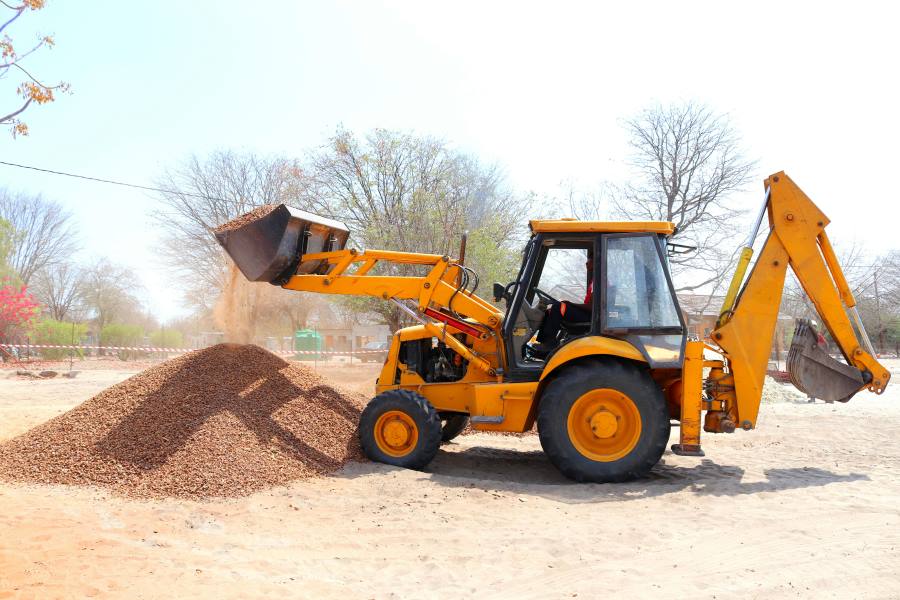2000+ Cashless Garages
96% Claims Settled (FY 24-25)


What is a Backhoe Loader and Its Uses, Types & Working?

Construction sites are always seen busy with heavy-duty machinery, including a backhoe loader, which is an indispensable and one of the most versatile machines of construction equipment.
This is because backhoes combine the capabilities of a tractor, excavator, and loader like JCB. Thus, they are among the essential machinery in construction and various industries.
In this article, you’ll get to know everything about a backhoe loader including its types, essential parts, how it works and operates, and its versatile uses.

Table of Contents

What is a Backhoe Loader?
Backhoe Loader Meaning
A backhoe loader is a compact construction machine designed to carry out the tasks of a tractor and a hydraulic excavator simultaneously. At the front end, it is built like a tractor with wheels or tires for better mobility, while its back end has a hydraulic excavator arm and a bucket.
This unique design allows backhoe loaders to easily lift, lower, dig, load, and transport debris and heavy materials, making them great for excavation and earthmoving projects. Thus, backhoe loaders are highly versatile, leading to their ever-increasing demand in several industries.
Backhoe Loader Specifications
Backhoe loaders typically weigh between 2 tons to 12 tons and can dig between 8 feet to 20 feet, depending on the model.
Their power ranges from 20 to 100 horsepower (hp), allowing them to lift around 1,500 lbs to 13,000 lbs with their bucket front end, up to a height of 8 feet - 12 feet.
Moreover, the powerful backhoe loaders are sturdy and weatherproof due to a high-grade iron bar and stainless-steel construction, which also makes them easier to drive and maintain.
What is the Working Principle of Backhoe Loader?
Being heavy machinery equipment that lifts, lowers and moves heavy loads, a backhoe loader uses hydraulics to perform all such operations.
The piston system called a hydraulic ram is applied in the backhoe arm with a bucket at one end for digging, and a loader at the other end for lifting and moving materials. This hydraulic system uses an incompressible fluid, usually oil, to apply force from one point to another in the backhoe loader.
So, to operate the machine, push down on the left piston to further push a certain amount of incompressible fluid. Now, all this force is transferred to the right piston, which is pushed forward. However, the pressure across the system remains must be balanced.
Since the pressure on the right-side piston is working on a larger area, it will push upward with greater force, moving the backhoe arm.
What are the Essential Parts of a Backhoe Loader?
- Boom: The boom is the large, vertical backhoe arm attached to the back of the tractor. It provides elevation for digging, and can lift, lower, or swing the load horizontally.
- Dipper: It is the hinged arm that allows the backhoe loader’s bucket to dig deeper into the ground, and it is attached to the end of the boom.
- Bucket: The bucket, available in various sizes, is attached to the dipper. It can carry out various tasks like scooping, lifting, and transporting materials. To scoop the load into the bucket, you must move it toward the dipstick, whereas to empty the bucket, it is to be moved away from dipstick.
- Cab: Located at the front end of the backhoe loader, the operator's cab is an enclosed space that serves as a comfortable sitting area with controls to operate the machine.
- Wheels or Tracks: Either wheels or tracks are attached to the bottom of the backhoe loaders to provide mobility, depending on the model and the terrain requirements.
How to Operate a Backhoe Loader?
Follow the given steps to know how to operate a backhoe loader:
Step 1: Prepare the backhoe loader
- Check the machine’s fluid levels and damaged or worn parts.
- Apply the parking brake and set the attachment control levers to HOLD, and the direction control lever to NEUTRAL.
- Now, hold the accelerator to HIGH IDLE position.
Step 2: Start the backhoe loader
- Turn the start switch to START.
- Mount the backhoe loader and fasten the seat belt.
- Rotate the seat to use the backhoe controls.
- Clear the area and turn on the ignition.
Step 3: Move different parts of the backhoe loader as required
- Now, first ensure the backhoe is steady by lowering the stabilizers.
- Then lift and secure the boom, stabilizers, and loader.
- Now start driving slowly where you want to use the backhoe loader.
- Shift the transmission forward and drive slowly, using only first and second gears.
- Now pull back to raise the loader boom arms or push forward to lower them.
- To open and dump the bucket, move the control to the right, whereas to close it, move the control to the left.
- Also, to raise the bucket you must pull straight toward the rear and push straight forward to lower it.
What are the Uses of Backhoe Loaders?

Backhoe loaders are extremely useful in various industries owing to their versatility and reliability. Some of their uses include:
- Construction projects
- Railway projects
- Digging trenches
- Excavating foundations for buildings and other structures
- Quarry and sand mining projects
- Site cleanup
- Extracting rock from riverbeds
- Small demolitions
- Transportation and loading and unloading of materials
- Powering building equipment
- Landscaping
- Agriculture
- Breaking asphalt
- Paving roads
- Removing snow
Thus, the backhoe loader is a simply an amazing machine, which can do a task in under 15 minutes that if done manually would have taken hours. Therefore, it's important to protect it as well.
Secure yourself financially in case your backhoe loader faces any damage or loss, such as accidents, theft, natural calamities, and third-party liability, etc., by covering it with a commercial vehicle insurance policy.













